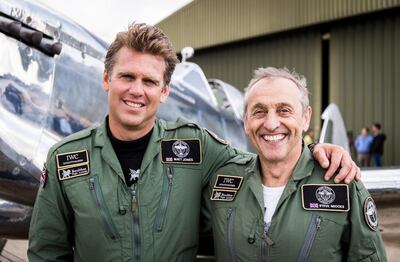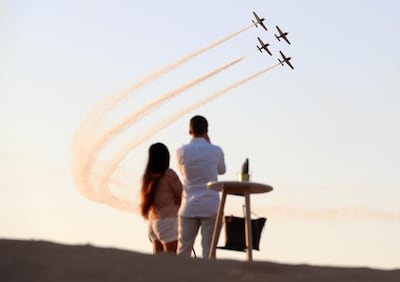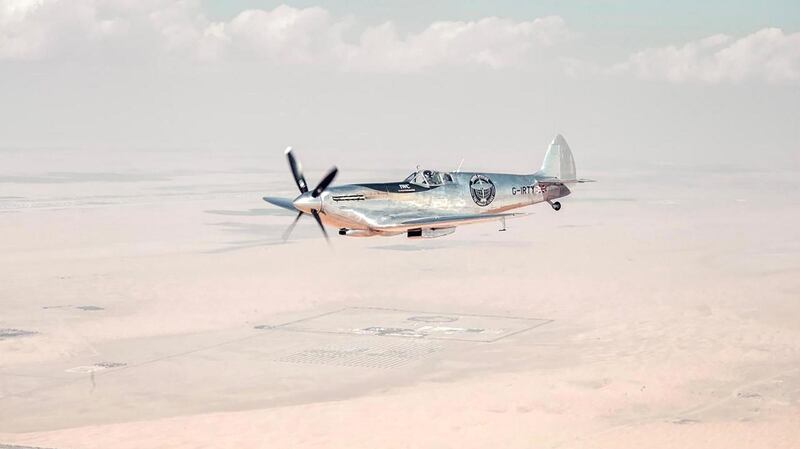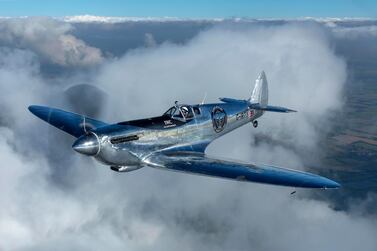It came in low over the desert. First the roar of the Merlin engine and then a flash of silver as one of the world’s most famous aircraft came into view.
A Second World War-era Spitfire landed in Abu Dhabi on Monday as part of an ambitious round-the-world flight attempt.
An aerial display by The Blades - a British civilian aerobatic team – on Tuesday in the Dubai desert celebrated its arrival.
Matt Jones, 46, and Steve Brooks, 58, are aiming to circumnavigate the globe for the first time in the single-seater Mk IX.
It took off from the UK in August and has stopped in the US, Russia and Pakistan. Now it is in the UAE for two nights before heading back to the UK, via Bahrain, on Wednesday.
The British pilots take turns guiding the single-seater craft and Mr Jones flew it from Pakistan to the UAE on Monday and recalls the moment he hit land.
“There were towering white clouds so we were weaving our way through those with the mountains underneath. It doesn’t get any better,” said Mr Jones. “Then it was just desert but a different colour than I’ve ever seen before. It had a real orange hue so I woke the photographer up because it was so beautiful.”
As he guided the plane into Al Bateen airport, he was struck by the neatness of the capital.

“Even from the air, it is immaculate. Everything was so meticulously laid out and perfect looking.”
Named "the longest flight", the endeavour involves the Spitfire visiting 100 locations in 30 countries over the course of a five-month, 43,450-kilometre journey.
Both pilots have carried passengers in Spitfires at their flight academy in the UK and found most were overjoyed by the experience. This - along with financial support of watchmaker IWC – made the journey possible. “We wanted people to hear it and to see it,” said Mr Brooks. “It is a chance to take the Spitfire back to the world.”
The silver Spitfire was built at the Castle Bromwich factory in England in 1943, fought dozens of combat missions and wound up in a museum before being purchased by the pair and restored.
The renovation took more than two years and 14,000 man-hours and its polished fuselage gives it its name. The gun sections were removed and extra fuel tanks added to increase the aircraft’s range to 1,600 kilometres from 804km.

“Three months into the job we went to the hangar and bits of Spitfire were strewn across the [ground]. We thought: can they really put this back together again?”
But the aircraft has performed admirably. The Supermarine Spitfire was designed by Reginald Mitchell in the 1930s and became the backbone of Britain’s RAF fighter fleet, turning the tide of war against the Nazis. More than 20,000 were built and it was flown by about 30 air forces. Only a handful are still airworthy.
“To coin a phrase from the Battle of Britain, you put the Spitfire on, you don’t get into it,” said Mr Jones. “A Spitfire is super light on the controls – rather than thinking you are moving a stick, you just think: ‘I want to be over there’. For original fighter pilots, they could concentrate on what’s going on around them.”
The two big challenges have been weather and logistics. They are flying VFR – visual flight rules – so if they encounter bad weather they must fly over or around the storm or else return to base. Securing supplies of rare avgas fuel has also been tricky.
“We have get barrels in position six months prior to us landing,” said Mr Jones. “And have guards to look after them. If barrels aren’t there, we are scuppered.”
Convincing every country to let the Spitfire in has also been a challenge with Hong Kong even requesting photographs of the fuel caps. “I must have sent 50 emails with responses to what they wanted,” said Mr Jones.
Both pilots are hoping the flight will inspire a new generation about the glory of flight. It is also their wish the appearance of the Spitfire will keep memories of its heroics against the Nazis fresh in people’s minds.
“It stands for freedom,” said Mr Brooks. “A symbol that united the world against tyranny. Aesthetically it is also probably the most beautiful airplane every built.”








